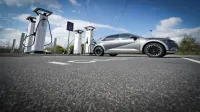Electric car glossary: EV batteries, charging stations, PHEVs explained

Thanks to electric vehicles, the automotive world has changed rapidly and seems to look completely different from one month to the next. Between all the new vehicles, tech, and features, there are hundreds of new ideas and terms to learn in order to become an EV master. That’s the bad news. The good news is that you don’t need to be anywhere near an EV master to own and drive an electric vehicle, and you certainly don’t need to know the ins and outs of everything going on under your car to enjoy the drive.
You need to know a few foundational terms to understand how to charge and care for an EV, especially the batteries. We’ve gathered a handful of the most common and important terms here. Let’s take a quick run through the EV terms you need to know.
Read more: Cheapest electric cars of 2022
Electric car battery terms you should know:
Battery pack: The battery pack is a completed system within an EV that includes the battery modules, cells, and related hardware.
Kilowatt: A kilowatt (kW) is equivalent to 1,000 watts, and is a unit used to measure an EV’s power from its batteries.
Kilowatt-Hour: A kilowatt-hour (kWh) is a measure of how many kilowatts an EV can supply within an hour.
Amp: Amp is short for ampere, which measures how fast an electric current flows. The term is typically used to describe charging speeds.
Cathode: Cathodes are the part of the battery where the current exits.
Solid-state batteries: You may hear the term solid-state thrown around when talking about upcoming EV technologies. Solid-state batteries lack the liquid electrolyte that lithium-ion batteries require, which makes them lighter, safer, and more energy dense. Automakers are hard at work developing solid-state batteries and the methods to produce them, but the technology isn’t yet ready for primetime.
Read more: Free EV charging perks for car buyers? Here’s what each automaker offers
Electric vehicle charging terms you should know:
Range: Range refers to the distance an electric vehicle can travel when the battery is fully charged. Several factors impact range, including temperature and driving style.
Read more: EV charging guide | What to know when buying an electric car
Level 1 charging: Level 1 charging typically refers to home charging using a standard 120-volt household outlet. Level 1 is very slow and should only be used when the vehicle can sit for an extended period.
Level 2 charging: Level 2 chargers still use household outlets but rely on 240-volt power instead of 120. A vehicle charging at Level 2 speeds recovers battery power several times more quickly than using a Level 1 charger.
Level 3 charging: Level 3 is the fastest charging speed currently available. A vehicle charging at Level 3 speeds can recover up to 20 miles of range per minute.
Direct current fast charging: Direct current fast charging, or DC fast charging, enables fast charging speeds of more than 50 kilowatts.
Read more: What do Level 1, Level 2 and DC fast charging (Level 3) mean?
More technologies related to electric cars:
Internal combustion engine: Internal combustion engines, sometimes shortened to ICE, are powered by fossil fuels. This term is used to describe gas and diesel engines as a differentiator from electric motors.
Plug-in hybrid: Plug-in hybrids (PHEV) have a battery and an electric motor(s), but they also have an internal combustion engine. PHEVs offer a short all-electric range and then function as a normal hybrid once battery power has been exhausted. The PHEV concept is a great stepping stone between gas and fully electric vehicles, and for many people, a PHEV means never having to stop at a gas station. People with short commutes can simply recharge at the end of the day to maintain range.




